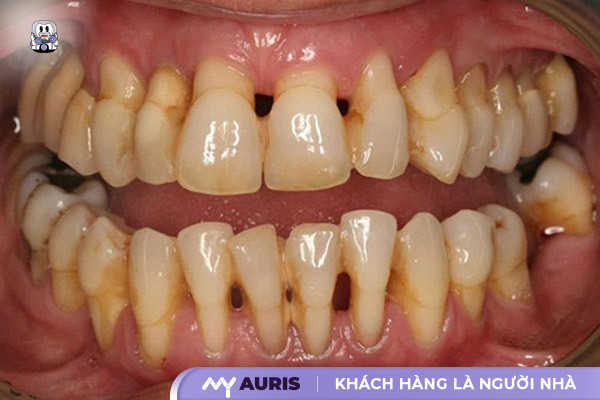The situation of porcelain teeth being exposed after being coated is a quite common problem, causing many negative effects on oral health. When making porcelain teeth with exposed roots, the patient may experience prolonged pain, bad breath, and even affect the digestive system and increase the risk of losing real teeth. Therefore, early recognition of signs of gapped porcelain teeth is extremely important to have a thorough solution, helping to protect oral health and maintain the effectiveness of the porcelain crown method.
Common signs of gapped porcelain teeth
Ceramic tooth restoration is an aesthetic dentistry technique that requires dentists to be highly skilled, careful and meticulous at each step. Any small mistake in the process of manufacturing or attaching porcelain crowns can cause serious porcelain dental complications, typically a leaking porcelain bridge. Below are clear signs of a leaky porcelain dental bridge that you need to pay attention to:
Black streaks appear on the gum line: When you closely observe the gum line around the porcelain crown, you will notice unusual black or gray gum lines.

Tooth root gap: The position of the porcelain tooth root adjacent to the gum is no longer tight, creating a clear gum gap, easily recognizable when observed with the naked eye.
Gradually receding gums: Gums recede over time, exposing the real tooth pulp inside, causing unsightliness and increased risk of tooth decay and gingivitis.
Tooth sensitivity: Feeling of sensitivity and pain when eating hot, cold or highly stimulating foods.
Loose porcelain teeth, difficulty chewing: When porcelain bridge If the porcelain crown is exposed, you will feel that the porcelain crown is unstable and loose, causing discomfort and difficulty chewing, reducing the quality of life.
Food gets stuck: Food particles often get stuck in the gap between the teeth, causing difficulty in daily oral hygiene, leading to bacterial growth and creating unpleasant bad breath.
If you are experiencing the above signs, you need to quickly go to a reputable dental facility for a dentist to examine, diagnose the cause and provide timely remedies. If left untreated for a long time, the condition will become more and more serious, greatly affecting oral health and chewing function.

Causes of exposed porcelain roots
Opened porcelain roots is a condition that occurs when the porcelain crown does not fully cover the root of the real tooth, creating a gap between the gum and the porcelain tooth. This condition not only affects oral aesthetics but also causes the risk of tooth loss eating, leading to unpleasant odors and increasing the risk of dental diseases.
Doctors’ poor skills
The condition of exposed porcelain roots can stem from the doctor’s skills If the tooth base grinding technique is not stable, the tooth base grinding technique will not be accurate, resulting in an incorrect tooth base grinding ratio. At that time, the porcelain crown will be warped and will not fit tightly to the real tooth.
Error in making porcelain tooth ribs
A porcelain crown that is not made to the correct size and shape standards can lead to a gap between the gum and the porcelain crown. The wrong impression of the jaw or the inexperienced technician can also cause this situation.

Improper oral care
Patients have the habit of brushing their teeth too hard, using a hard-bristled toothbrush or brushing horizontally which can cause damage. Long-term misalignment of porcelain teeth leads to exposed roots. In addition, chewing food that is too hard or tough also affects the durability of porcelain teeth.

Exposure of tooth roots due to longevity
The lifespan of porcelain crowns is limited. After a long period of use, porcelain crowns may become abraded or become loose, increasing the risk of gaps appearing in porcelain teeth.
Optimal solution to overcome the problem of porcelain teeth with exposed roots
The condition of porcelain teeth with exposed roots not only affects the aesthetics but also poses a potential risk of serious dental diseases. Therefore, when you detect this sign, you You should immediately go to a reputable dentist to have a doctor examine, determine the cause and come up with a suitable treatment plan.
In most cases, the doctor will remove the old porcelain crown, check the condition of the tooth pulp, then take an impression of the new tooth to re-create the porcelain crown to ensure maximum fit. Remaking the porcelain tooth with high-quality materials helps improve the condition quality of porcelain teeth, increasing the durability of the glue and limiting the risk of tooth gap recurrence.
In case the tooth gap lasts for a long time leading to dental diseases, the doctor will prioritize thorough treatment before performing porcelain crowns. This helps ensure long-term oral health and avoid unwanted complications.
If the porcelain tooth is exposed due to poor quality glue or errors in taking the tooth impression, the doctor can simply adjust it without removing the porcelain crown to redo the tooth impression. aria-describedby=”caption-attachment-56044″ style=”width: 600px” class=”wp-caption aligncenter”> Open porcelain root is not a rare condition, especially when performed at low-quality dentists and inexperienced doctors. If you are experiencing this problem, choosing a reputable dentist with a team of good specialists and advanced technology is essential to ensure effective and durable porcelain restorations. Dental My Auris – A reputable, high-quality address for porcelain tooth restoration My Auris Dental is one of the leading addresses for porcelain tooth restoration, highly appreciated by many customers thanks to its outstanding service quality and modern technology: If you are worried about exposed porcelain roots, please contact My Auris Dental immediately for detailed advice and effective support. With the dedication of a team of experienced doctors and modern technology, you can be completely assured of the results of porcelain tooth restoration here.
Reputable dental address that helps fix exposed porcelain roots effectively
Porcelain tooth restorations are all made according to strict aseptic standards, preventing the risk of infection.





